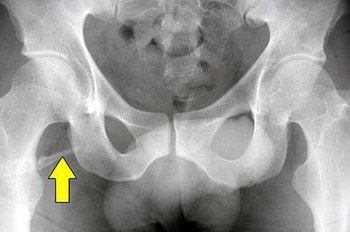A pelvic digit, pelvic finger, or pelvic rib is a rare congenital abnormality in humans, in which bone tissue develops in the soft tissue near the pelvis, resembling a rib or finger and often divided into one or more segments with pseudo-articulations. Pelvic digits are typically benign and asymptomatic, and are usually discovered accidentally. Approximately 41 cases have been reported.[1]

The pelvic digit was first reported by D. Sullivan and W.S. Cornwell in 1974.[2] Pelvic digits may be located at any level of the pelvis, the lower ribs, or even the anterior abdominal wall. It is theorized that pelvic digit anomalies arise during the mesenchymal stage of bone growth, within the first six weeks of embryogenesis. Their formation may result from a failure of the primordium of the coccyx to fuse to the vertebral column, leading to the independent development of a proto-rib structure.[1]
See also
editReferences
edit- ^ a b Van Breuseghem, I. (2006). "The pelvic digit: a harmless 'eleventh' finger". British Journal of Radiology. 79 (945): 106–107. doi:10.1259/bjr/17378249. PMID 16940362.
- ^ Pandey, Vivek; Ajay Singh Thakur; Kiran K.V. Acharya; P. Sripathi Rao (2009). "The pelvic digit 'eleventh finger'". Indian Journal of Orthopaedics. 43 (1): 97–98. doi:10.4103/0019-5413.45332 (inactive 1 November 2024). ISSN 1998-3727. PMC 2739487. PMID 19753190.
{{cite journal}}: CS1 maint: DOI inactive as of November 2024 (link)
External links
edit- Radiographs of a pelvic digit
- Lame, Edwin L. (1977). "Case report 32". Skeletal Radiology. 2: 47–48. doi:10.1007/BF00364629. S2CID 32499960.
- Granieri, G. F.; Bacarini, Lamberto (1996). "The pelvic digit: Five new examples of an unusual anomaly". Skeletal Radiology. 25 (8): 723–726. doi:10.1007/s002560050168. PMID 8958617. S2CID 19362429.
- "The Pelvic Digit – A Rare Developmental Anomaly"] in Acta Radiologica